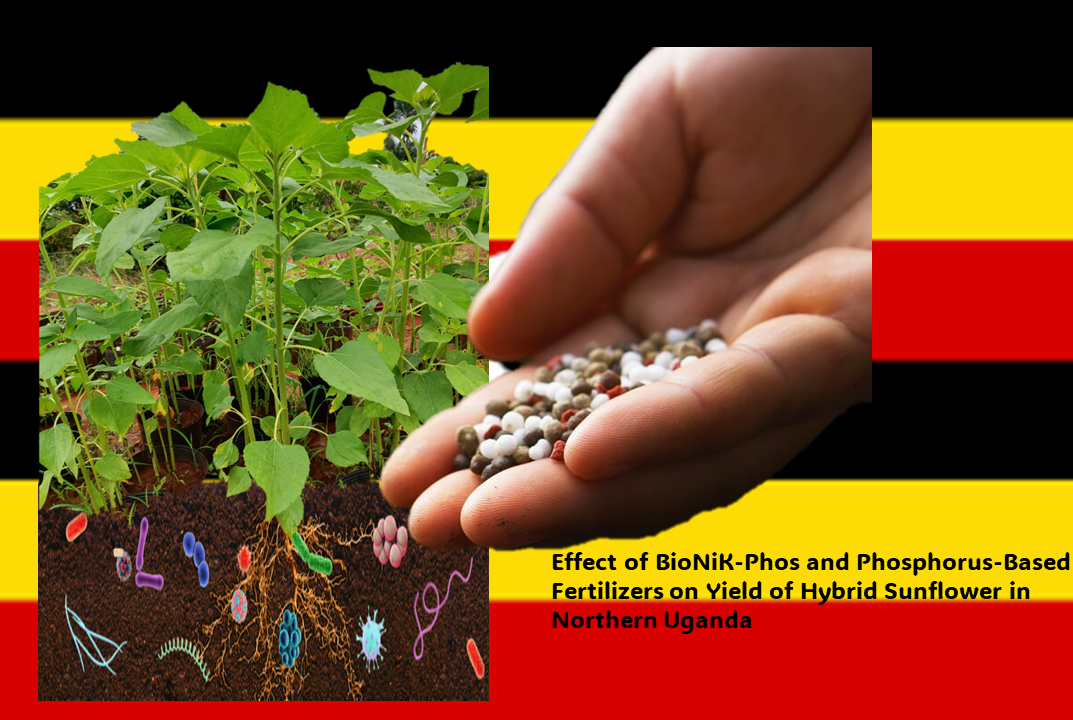Effect of BioNiK-Phos and Phosphorus-based fertilizers on yield of hybrid sunflower in Northern Uganda
DOI:
https://doi.org/10.14295/bjs.v3i4.551Keywords:
bioNiK-Phos, di-ammonium phosphate, fertilizer, sunflower, micro-dosingAbstract
The sunflower oil seed industry is one of the promising business sectors in Uganda for both domestic and export markets. Both open-pollinated varieties and hybrids are grown in Uganda. Average yields of open-pollinated varieties in farmers’ fields range from about 750-900 kg ha-1 and hybrids about 2,000 kg/ha. For high production and productivity, sunflower requires fertilizers. The objective of this study was to establish the effects of BioNik-Phos and di-ammonium phosphate (DAP) fertilizers micro-dosing on yield of sunflower hybrid (PAN 5057) in Northern Uganda in 2021b and 2022a seasons. Field experiments were laid using a randomized complete block design (RCBD) with 4 replications per location in 3 locations in Alebtong District (Abako, Aloi and Angeta). There were significant (P < 0.05) differences in sunflower yields across treatments in all the three locations (Abako: 1,250-3,524 kg ha-1, Aloi: 1,274-3,488 kg ha-1 and Angeta: 1,238-3,369 kg ha-1) in 2021 with or without micro-dosing with BioNiK-Phos and DAP fertilizer. A similar trend was recorded for 2022a season (Abako: 1,268-3,500 kg ha-1, Aloi: 1,357-3,607 kg ha-1 and Angeta: 1,286-3,417 kg ha-1). The effect of DAP fertilizer micro-dosing on sunflower hybrid productivity was three folds in both years. BioNiK-Phos effect was, however, not significantly different (P < 0.05) from the control. This is the first report of the effect of BioNiK-Phos and DAP fertilizers micro-dosing of sunflower in Northern Uganda.
References
Abaca, A., Odama, E., Komakech, A., Kassim, S., & Walakira, J. K. (2022). Effect of Phosphorus-based fertilizer on groundnut yield and incidence of groundnut rosette disease in West Nile region of Uganda. Uganda Journal of Agricultural Sciences, 21 (2), 1-14. https://www.ajol.info/index.php/ujas/article/view/247555
Abbadi, J., & Gerendás, J. (2011). Effects of phosphorus supply on growth, yield, and yield components of safflower and sunflower. Journal of Plant Nutition, 34(12), 1769-1787. https://doi.org/10.1080/01904167.2011.600405 DOI: https://doi.org/10.1080/01904167.2011.600405
Adeleke, B. S., & Babalola, O. O. (2020). Oilseed crop sunflower (Helianthus annuus) as a source of food: Nutritional and health benefits. Food Science and Nutrition, 8(9), 4666-4684. https://doi.org/10.1002/fsn3.1783 DOI: https://doi.org/10.1002/fsn3.1783
Anyanga, O.W. (2003). The development and evaluation of sunflower varieties and hybrids in Uganda. In: Proc. 16th International Sunflower Conference, Fargo, ND USA, Breeding and Genetics, 441-450 p.
Elobu, P., Ocan, J. R., Olinga, J., & Anyanga, W. O. (2013). Intercropping sunflower with beans, groundnuts, maize and sorghum in Uganda. In: 11th African Crop Science Conference Proceedings, Sowing Innovations for Sustainable Food and Nutrition Security in Africa, Entebbe, Uganda, 14-17 October, 73-77. https://www.cabidigitallibrary.org/doi/full/10.5555/20163288827
Godfray, H. C. J., Beddington, J. R., Crute, I. R., Haddad, L., Lawrence, D., Muir, J. F., & Toulmin, C. (2010). Food security: The challenge of feeding 9 billion people. Science, 327(5967), 812-818. https://doi.org/10.1126/science.1185383 DOI: https://doi.org/10.1126/science.1185383
Hinsinger, P. (2001). Bioavailability of soil inorganic P in the rhizosphere as affected by root-induced chemical changes: A review. Plan and Soil, 237(2), 173-195. https://doi.org/10.1023/A:1013351617532 DOI: https://doi.org/10.1023/A:1013351617532
Kamoga, E. (2011). Planting the Seed: Improving oilseed supply in north eastern Uganda. http://www.snvworld.org/sites/www.snvworld.org/files/publications/improving_oil seed_supply.final_.pdf
Kandel, S., Joubert, P., & Doty, S. (2017). Bacterial endophyte colonization and distribution within plants. Microorganisms, 5(4), 77-89. https://doi.org/10.3390/microorganisms5040077 DOI: https://doi.org/10.3390/microorganisms5040077
Khondoker, A. M., Gideon, K., & Sieglinde, S. (2022). Potential impacts of Ukraine-Russia armed conflict on global wheat food security: A quantitative exploration. Global Food Security, 35, 1-12. https://doi.org/10.1016/j.gfs.2022.100659. DOI: https://doi.org/10.1016/j.gfs.2022.100659
McGill, S. M. (2012). ‘Peak’phosphorus? The implications of phosphate scarcity for sustainable investors. Journal of Sustaiable Financial Investigation, 2(3-4), 222-239.
Mello Prado, R., & Leal, R. M. (2006). Nutritional disorders due to deficiency in sunflower var. Catissol-01. Pesquisa Agropecuária Tropical, 36(3), 187-193.
Murendo, C., & Wollni, M. (20150. Ex-post impact assessment of fertilizer microdosing as a climate smart technology in sub-Saharan Africa. Available in: https://cgspace.cgiar.org/bitstream/handle/10568/67122/Micro%20dosing%20as%20cli mate%20smart%20technology_Impact%20Assessment.pdf. Access in 3 February, 2021
Nyamaizi, S. M., Tumuhairwe, J. B., Amayo, R., Tumuhe, C. L., Tereka, E., Nabirye, D. L., & Obaa, B. B. (2020). Phosphorus fertilizer rating and rhizobia inoculation for improved productivity of cowpea in Northern Uganda. American Journal of Plant Sciences, 11(09), 1505. https://doi.org/10.4236/ajps.2020.119109 DOI: https://doi.org/10.4236/ajps.2020.119109
Oliveira, A. K. S., Soares, E. B., Santos, M. G., Lins, H. A., Souza, M. F., Coêlho, E. S., Silveira, L. M., Mendonça, V., Júnior, A. P. B., & Lopes, W. A. R. (2022). Efficiency of Phosphorus use in sunflower. Agronomy, 12(7), 1558. https://doi.org/10.3390/agronomy12071558 DOI: https://doi.org/10.3390/agronomy12071558
Oliveira-Longatti, S. M., Marra, L. M., Soares, B. L., Bomfetti, C. A., Silva, K., Ferreira, P. A. A., & Moreira, F. M. S. (2014). Bacteria isolated from soils of the western Amazon and from rehabilitated bauxite-mining areas have potential as plant growth promoters. World Journal of Microbiology & Biotechnology, 30(4), 1239-1250. https://doi.org/10.1007/s11274-013-1547-2 DOI: https://doi.org/10.1007/s11274-013-1547-2
Sadozai, G. U., Farhad, M., Khan, M. A., Khan, E. A., Niamatullah, M., Baloch, M. S., & Wasim, K. (2013). Effect of different phosphorous levels on growth, yield and quality of spring planted sunflower. Pakistan Journal of Nutrition, 12(12), 1070-1084. DOI: https://doi.org/10.3923/pjn.2013.1070.1074
Hoque, T. S., Sarkar, D., Datta, R., Kibria, M. G., Ullah, R., Ahmed, N., Hossain, M. N., Masood, A., & Anjum, N. (2024). Sustainable management of Phosphorus in agriculture for environmental conservation. IntechOpen. DOI: 10.5772/intechopen.113086. DOI: https://doi.org/10.5772/intechopen.113086
Soomro, F., Talpur, N. A., Soothar, M. K., Jamro, S. B., Panhwar, A. A., Memon, N. A., & Soomro, M. H. (2018). Identification of phosphorus use efficiency of different sunflower genotypes at Tandojam-Pakistan. Pure Applied Biology, 7(3), 1026-1037. https://www.cabidigitallibrary.org/doi/full/10.5555/20193442078 DOI: https://doi.org/10.19045/bspab.2018.700122
Velázquez, E., Rojas, M., Lorite, M. J., Rivas, R., Zurdo-Piñeiro, J. L., Heydrich, M., & Bedmar, E. J. (2008). Genetic diversity of endophytic bacteria which could be found in the apoplastic sap of the medullary parenchym of the stem of healthy sugarcane plants. Journal of Basic Microbiology, 48(2), 118-124. https://doi.org/10.1002/jobm.200700161 DOI: https://doi.org/10.1002/jobm.200700161
Veneklaas, E. J., Lambers, H., Bragg, J., Finnegan, P. M., Lovelock, C. E., Plaxton, W. C., & Raven, J. A. (2012). Opportunities for improving phosphorus-use efficiency in crop plants. New Phytopathology, 195(2), 306-320. https://doi.org/10.1111/j.1469-8137.2012.04190.x DOI: https://doi.org/10.1111/j.1469-8137.2012.04190.x

Downloads
Published
How to Cite
Issue
Section
License
Copyright (c) 2024 Alfred Kumakech, Frank Laban Turyagyenda

This work is licensed under a Creative Commons Attribution 4.0 International License.
Authors who publish with this journal agree to the following terms:
1) Authors retain copyright and grant the journal right of first publication with the work simultaneously licensed under a Creative Commons Attribution License that allows others to share the work with an acknowledgement of the work's authorship and initial publication in this journal.
2) Authors are able to enter into separate, additional contractual arrangements for the non-exclusive distribution of the journal's published version of the work (e.g., post it to an institutional repository or publish it in a book), with an acknowledgement of its initial publication in this journal.
3) Authors are permitted and encouraged to post their work online (e.g., in institutional repositories or on their website) prior to and during the submission process, as it can lead to productive exchanges, as well as earlier and greater citation of published work.



